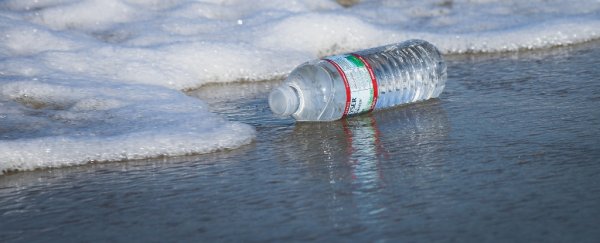It took us a while to notice, but now it's clear that plastic pollution is everywhere: in the air we breathe, in the food we eat, and the water we drink.
Last year, an unsettling analysis found more than 90 percent of the world's most popular bottled water contained tiny bits of plastic. In some cases, concentrations reached 10,000 pieces per litre.
Moved by these results, the World Health Organisation decided to launch a safety review. If microplastics were being swallowed day in and day out by humans all over the world, then health officials needed to know what that was doing to our bodies.
The results from their analysis have now been published, but they don't exactly inspire a sigh of relief. With scant data available on both hazard and exposure, the authors were only able to review nine studies on microplastics in drinking water, and many of these were deemed unreliable in some way.
"We urgently need to know more about the health impact of microplastics because they are everywhere - including in our drinking-water," says WHO public health director Maria Neira.
"Based on the limited information we have, microplastics in drinking water don't appear to pose a health risk at current levels. But we need to find out more."
The sheer scarcity of data makes it difficult to draw any firm conclusions. The review included studies that used different cut-offs for reporting microplastic sizes, and different methods, sampling and analysis tools.
What's more, while reliable data on microplastics in general are limited, even fewer studies have looked at their specific effects on human health.
Today, microplastic research is in its infancy, but the results from WHO's report do highlight some interesting initial patterns. For instance, the review found large particles of plastic, usually over 150 micrometres, tend to appear less often in drinking water than smaller particles. And some of the smallest ones were no bigger than 1 micrometre.
Just because plastic is present in our water, that doesn't necessarily mean it is harmful to human health. Plastic polymers are generally considered to be of low toxicity and initial results suggest intestinal absorption is also very low.
Nevertheless, a string of worrying studies on our plastic consumption have raised genuine questions and concerns among the public. If microplastics can enter the gut, there's the potential they might release toxic substances or chemical additives, causing oxidative stress or even cancer.
The few studies done so far haven't shown anything too worrying, but most of these have focused on larger pieces of plastic and not nanoparticles.
"Therefore," the WHO report concludes, "it is not possible to draw any firm conclusions on toxicity related to microplastic exposure through drinking-water, particularly for the smallest particles, but no reliable information suggests it is a concern."
While this initial conclusion is somewhat comforting, there's still plenty of reason to investigate the issue more. The authors of the report admit the current state of research is not good enough, and they are calling on scientists to design better and more reliable studies to figure out how plastic affects our health and how we can safely remove it from our drinking water.
"The key message for water authorities is that concerns over microplastics in drinking-water should not divert resources or attention away from the things which do present real public health risks in drinking water," says Stuart Khan, a civil and environmental engineer at the University of New South Wales who was not involved in the report.
"These are microorganisms such as viruses and bacteria, as well as some chemical contaminants such as lead."
Other scientists, however, thought the report was a little too dismissive. Paul Harvey, an environmental scientist at Macquary University, says the review teeters on a 'no data no problem' mindset.
"While it is encouraging to see the WHO take the lead on this issue and conduct this large scale review of microplastics in drinking water, the conclusions could be better refined," writes Harvey, who was not involved in the report.
"The report highlights a paucity of research and subsequent knowledge surrounding both the health impacts of microplastic ingestion and microplastics in drinking water, however errs on the side of microplastics in drinking water being of no health concern."
Until we get a reliable body of data, the health effects of microplastics are anyone's guess.
The findings are published in a new WHO report.
